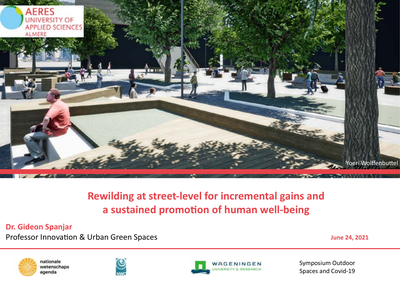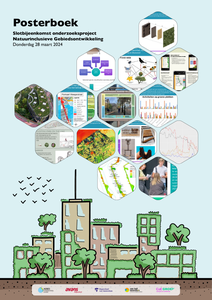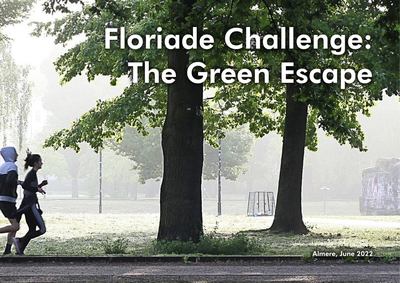Cities are confronted with more frequent heatwaves of increasing intensity discouraging people from using urban open spaces that are part of their daily lives. Climate proofing cities is an incremental process that should begin where it is needed using the most cost-efficient solutions to mitigate heat stress. However, for this to be achieved the factors that influence the thermal comfort of users, such as the layout of local spaces, their function and the way people use them needs to be identified first. There is currently little evidence available on the effectiveness of heat stress interventions in different types of urban space.The Cool Towns Heat Stress Measurement Protocol provides basic guidance to enable a full Thermal Comfort Assessment (TCA) to be conducted at street-level. Those involved in implementing climate adaptation strategies in urban areas, such as in redevelopments will find practical support to identify places where heat stress may be an issue and suggestions for effective mitigation measures. For others, such as project developers, and spatial designers such as landscape architects and urban planners it provides practical instructions on how to evaluate and provide evidence-based justification for the selection of different cooling interventions for example trees, water features, and shade sails, for climate proofing urban areas.
MULTIFILE

Built environments are increasingly vulnerable to the impacts of climate change. Most European towns and cities have developed horizontally over time but are currently in the process of further densification. High-rise developments are being built within city boundaries at an unprecedented rate to accommodate a growing urban population. This densification contributes to the Urban Heat Island phenomenon and can increase the frequency and duration of extreme heat events locally. These new build-up areas, in common with historic city centres, consist mainly of solid surfaces often lacking open green urban spaces.The Intervention Catalogue is the third publication in a series produced by the Cool Towns project and has been designed as a resource for decision makers, urban planners, landscape architects, environmental consultants, elected members and anyone else considering how to mitigate heat stress and increase thermal comfort in urban areas. Technical information on the effectiveness of the full array of intervention types from trees to water features, shading sails to green walls, has been assessed for their heat stress mitigation properties, expressed in Physiological Equivalent Temperature (PET). The results shown in factsheets will help the process of making an informed, evidence based, choice so that the most appropriate intervention for the specific spatial situation can be identified.
DOCUMENT

With increase in awareness of the risks posed by climate change and increasingly severe weather events, attention has turned to the need for urgent action. While strategies to respond to flooding and drought are well-established, the effects - and effective response - to heat waves is much less understood. As heat waves become more frequent, longer-lasting and more intense, the Cool Towns project provides cities and municipalities with the knowledge and tools to become heat resilient. The first step to developing effective heat adaptation strategies is identifying which areas in the city experience the most heat stress and who are the residents most affected. This enables decision-makers to prioritise heat adaptation measures and develop a city-wide strategy.The Urban Heat Atlas is the result of four years of research. It contains a collection of heat related maps covering more than 40,000 hectares of urban areas in ten municipalities in England, Belgium, The Netherlands, and France. The maps demonstrate how to conduct a Thermal Comfort Assessment (TCA) systematically to identify heat vulnerabilities and cooling capacity in cities to enable decision-makers to set priorities for action. The comparative analyses of the collated maps also provide a first overview of the current heat resilience state of cities in North-Western Europe.
DOCUMENT

De klimaatverandering was de afgelopen zomer met zijn heftige hittegolven wederom voelbaar. Warmterecords werden verbroken en stedelingen zochten massaal verkoeling buiten de stad. Volgens het Koninklijke Nederlandse Meteorologisch Instituut (KNMI) zullen hittegolven komende jaren vaker voorkomen en heviger zijn. Dit geeft een belangrijke aanleiding om de gehele inrichting van onze steden te herzien. Immers, we willen onze steden ook bij hoge temperaturen leefbaar houden.
MULTIFILE

People during this Covid-19 year were forced to spend more time at home due to the lockdown and extreme weather conditions. Before the crisis, people already spent approximately 90 percent of their time indoors and relied on nearby public outdoor spaces for social and physical activities to maintain their health and well-being. During the pandemic, unhealthy, overcrowded, uncomfortable outdoor public spaces and a lack of greenery likely encouraged people to stay indoors even more. In city centres, greenery is often scarce: municipalities struggle to find nature-based solutions that meet the multiple functions of these areas.Fortunately, pandemics appear to spur cities to create healthier, greener environments. The nineteenth-century cholera pandemics, for example, led many western cities to establish large public parks to act as green lungs. These include Central Park and Prospect Park in New York, designed by the influential landscape architect Frederick Law Olmsted. The Covid-19 crisis creates the momentum to bring nature back into our cities and to repair vital ecosystem functions and derived Urban Ecosystem Services (UESs).In this action-research study we adopted the Panarchy model and its principle that initiatives on a fine-grained scale can eventually have a positive impact on the entire ecosystem. Green interventions at street-level hold the promise that they may activate communities to initiate change for more social-ecological resilience. This paper describes two experimental projects: The Climate Cube, installed at a shopping centre in the Nieuw-West district in Amsterdam, and the Rewilding Stepping Stones in the centre of New Town Almere. The Climate Cube consists of a pergola, large, interconnected planter boxes, and benches on each side and acts as a cool social spot. The aim is to explore how it might improve visitors’ (thermal) comfort and to build community support before larger redevelopment projects are launched. The Rewilding Stepping Stones are made of biobased and recycled materials and planted with native species to encourage nature to return to the city centre.
DOCUMENT

While the optimal mean annual temperature for people and nations is said to be between 13 °C and 18 °C, many people live productive lives in regions or countries that commonly exceed this temperature range. One such country is Australia. We carried out an Australia-wide online survey using a structured questionnaire to investigate what temperature people in Australia prefer, both in terms of the local climate and within their homes. More than half of the 1665 respondents (58%) lived in their preferred climatic zone with 60% of respondents preferring a warm climate. Those living in Australia's cool climate zones least preferred that climate. A large majority (83%) were able to reach a comfortable temperature at home with 85% using air-conditioning for cooling. The preferred temperature setting for the air-conditioning devices was 21.7 °C (SD: 2.6 °C). Higher temperature set-points were associated with age, heat tolerance and location. The frequency of air-conditioning use did not depend on the location but rather on a range of other socio-economic factors including having children in the household, the building type, heat stress and heat tolerance. We discuss the role of heat acclimatisation and impacts of increasing air-conditioning use on energy consumption.
MULTIFILE

Ageing brings about physiological changes that affect people’s thermal sensitivity and thermoregulation. The majority of older Australians prefer to age in place and modifications to the home environment are often required to accommodate the occupants as they age and possibly become frail. However, modifications to aid thermal comfort are not always considered. Using a qualitative approach this study aims to understand the thermal qualities of the existing living environment of older South Australians, their strategies for keeping cool in hot weather and warm in cold weather and to identify existing problems related to planning and house design, and the use of heating and cooling. Data were gathered via seven focus group sessions with 49 older people living in three climate zones in South Australia. The sessions yielded four main themes, namely ‘personal factors’, ‘feeling’, ‘knowing’ and ‘doing’. These themes can be used as a basis to develop information and guidelines for older people in dealing with hot and cold weather. Original publication at MDPI: https://doi.org/10.3390/ijerph16060935 © 2018 by the authors. Licensee MDPI.
MULTIFILE

At a time when the population is ageing and most people choose to live in their own home for as long as possible, it is important to consider various aspects of supportive and comfortable environments for housing. This study, conducted in South Australia, aims to provide information about the links between the type of housing in which older people live, the weather and occupants’ heating and cooling behaviours as well as their health and well-being. The study used a Computer-Assisted Telephone Interviewing (CATI) system to survey 250 people aged 65 years and over who lived in their own home. The respondents were recruited from three regions representing the three climate zones in South Australia: semi-arid, warm temperate and temperate. The results show that while the majority of respondents reported being in good health, many lived in dwellings with minimal shading and no wall insulation and appeared to rely on the use of heaters and coolers to achieve thermally comfortable conditions. Concerns over the cost of heating and cooling were shared among the majority of respondents and particularly among people with low incomes. Findings from this study highlight the importance of providing information to older people, carers, designers and policy makers about the interrelationships between weather, housing design, heating and cooling behaviours, thermal comfort, energy use and health and well-being, in order to support older people to age in place independently and healthily. https://doi.org/10.1016/j.buildenv.2019.03.023 LinkedIn: https://www.linkedin.com/in/jvhoof1980/
MULTIFILE

In het SIA-project Natuurinclusieve Gebiedsontwikkeling onderzochten vier hogescholen - Aeres Hogeschool, Avans Hogeschool, Hogeschool van Amsterdam enHogeschool Van Hall Larenstein - drie schaalniveaus van gebiedsontwikkeling om de transitie naar natuurinclusieve gebiedsontwikkeling te versnellen. Gekoppeld aan driecasussen waren dit: gebouw (Spoorzone Waarder), straat (Knowledge Mile Park - KMP - Amsterdam), en gebied (Almere Centrum-Pampus).Tijdens de slotbijeenkomst van het project was er een posterexpositie georganiseerd waarbij op de posters de belangrijksteuitkomsten van diverse deelonderzoeken werden gepresenteerd. De posters van onderzoekers en studenten zijn in deze publicatie gebundeld.
DOCUMENT

Almere is a green city where the greenery extends into the centre through a framework of nature, forests, parks and canals. With this green environment, Almere fulfils an important condition for a liveable city, where it is pleasant to live and work. An important goal for the municipality is to challenge its residents to develop a healthy lifestyle by using that green framework.But what really motivates Almeerders to go outside to exercise, enjoy the surroundings and meet each other? Are there sufficient green meeting or sports facilities nearby? Could the routes that connect the living and working environment with the larger parks or forests be better designed? And can those routes simultaneously contribute to climate adaptation?With the Green Escape Challenge, we invited students and young professionals to work on these assignments together.
DOCUMENT
